
National science academy of Ukraine
National science center "Kharkiv institute of physics and technology"
Institute of high-energy and nuclear physics

National science academy of Ukraine
National science center "Kharkiv institute of physics and technology"
Institute of high-energy and nuclear physics

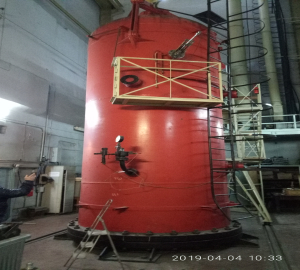
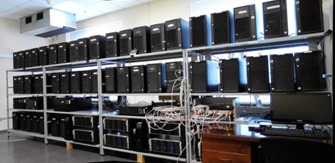
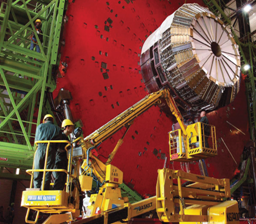

Department Of Radiation Physics And Multichannel Track Detectors
Head Of Department – N. I. Maslov (Ph. D. In Phys.-math. Sc.)
Phone/Fax: +38(057)3356654/+38(057)3356120
E-mail: nikolai.maslov@kipt.kharkov.ua; Nikolai.Maslov@cern.ch
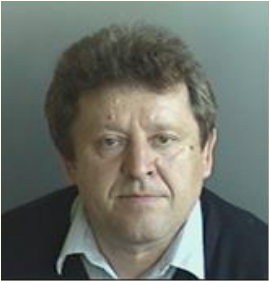
Department of radiation physics and multichannel track detectors was created at the beginning of 90th on the basis of a part of the integrated department 32-00, which was headed by N. F. Shulga. The main research directions of the integrated department 32-00 were upgrading of the experimental direct output hall on LEA-2000 and investigating into the interaction between ultra-relativistic electrons and crystals. In 2012 the physicists of the integrated department 32-00 Ganenko V.B., Grynenko O.O., Kasilov V.I., Maslov N.I., Morokhovsky V.L., Truten’ V.I., Fomin S.P., Shramenko B.I., as well as, Dovbnya A.N. and Kovalenko G.D. were awarded, according to the results of investigations into the interaction betwen ultra-relativistic electrons and crystals, a title of the Laureate of State Prize in the field of science and technology for the cycle of works on "DYNAMICS OF HIGH-ENERGY PARTICLE BEAMS IN CRYSTAL STRUCTURE: BEAM PARAMETER CONTROL AND GAMMA- RADIATION PROPERTIES".
Main directions of research activity
1. Multichannel track detectors. Development and study
Since 1994 physicists of the department, participate in the preparation and realization of the international heavy-ion experiment on the supercollider (ALICE) at CERN (Geneva). For the inner tracking system of the experimental facility "ALICE", a single-coordinate microstrip detector (750 detecting elements) and two-coordinate microstrip detector (1536 detecting elements) were designed, built and investigated. In NSC KIPT the unique equipment for testing detectors was built: micropositional automatic equipment, multichannel spectrometric stands, automated equipment for studying the long-term stability and other detector characteristics.
The NSC KIPT team participated in the development and testing detectors of the ALICE experiment (Fig. 3) with financial support of CERN and INFN (National Institute of Nuclear Physics in Trieste, Italy).
2. Investigation into the interaction between ultrarelativistic electrons (positrons) and crystals.
The mechanisms of electron emission in the crystal matter depend on the particle dynamics in the strong fields near the crystal axes and planes. The nature of the particle movement is determined by the conditions of crystal orientation relative to the electron beam. When the beam penetrates deep into the crystal the motion character changes and this occur, mainly, at distances to ∼ 10 microns at the initial electron energy of ∼ 200 MeV. To study the mechanisms responsible for emission of electrons in crystals at the facility of the MAX-laboratory (Lund, Sweden) systematic measurements were carried on the emission spectra of 200 MeV electrons in diamond crystals of 100 and 50 microns, at different angles of beam impingement along the crystal axis <100>. With support from the Russian Foundation for Basic Research (projects № H. 4.45.90.11, 1080 and № 13-02-90434), the Directorate of the State Research Center - Institute for High Energy Physics (IHEP) (Russia, Protvino,) and the State Fund for Fundamental Research of Ukraine (projects № F40.2/092 and № F53.2/107) the investigations on the output/collimation of a proton beam, bended by a silicon crystal, were carried out on the IHEP accelerator U-70 in Protvino. In the experiment, the silicon crystal was oriented in such a way that a proton beam entered it near the axis <110>. The axial potential is about 5 times higher than the planar one that can be used to bend the particle beam in two modes – the mode of plane channeling and mode of dynamic chaos in the curved crystal, proposed by the academician of NAS of Ukraine N.F. Shulga and colleagues. The efficiency of bending protons of 50, 15 and 1.3 GeV by the curved silicon crystal using the planar channeling and due to stochastic mechanism was studied. The efficiency of the stochastic mechanism increases with proton energy decreasing, while that of the planar channeling drops down.
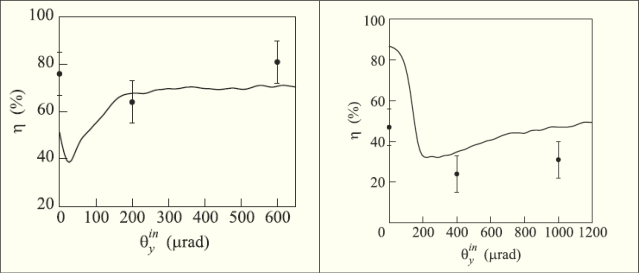 Efficiency of bending the proton beam of 50 GeV (left) and 1.3 GeV (right) by a curved silicon
crystal as a function of the initial angle between the middle particle pulse and the crystal
curvature area
Efficiency of bending the proton beam of 50 GeV (left) and 1.3 GeV (right) by a curved silicon
crystal as a function of the initial angle between the middle particle pulse and the crystal
curvature area
3. Investigation into the atomic nucleus structure and photonuclear reaction mechanisms.
To carry out the experiments for measurements of the cross-sections and cross-section asymmetry in the reactions of photofission of helium nucleus ( 4Не(γ,n) 3Нe) and carbon nucleus ( 12С(γ,p) 11В) at the facility of the MAX-Laboratory ( Lund, Sweden), in the period from 2001 to 2007, at the initiative of the physicists of the department a linearly polarized photon beam was produced basing on the process of coherent electron bremsstrahlung (CEB) in the diamond crystal. Electrons were extracted from the MAX-1 storage ring, operating in the mode of a stretcher. Ця робота була підтримана: ● 6-frame program of EC Hadron Physics – JRA3: EuroTag Project - European Tagged Photon Facilities ● STCU Project - 3239 The specialists of the department have designed a goniometer and a vacuum chamber for it, developed a goniometer operation program and a crystal positioning technique as well as a system for beam parameter control during the experiment. The linear bremsstrahlung polarization in the coherence peak maximum at the peak energy of ∼50 MeV was ∼20% without collimation and increased to 40% with a tight collision. The beam produced at the initial electron energy of 200 MeV has provided the measurements of polarization observables in the range of energies from the giant dipole resonance to Eγ∼80 MеВ. The beam produced in the period from 2007 to 2011 has provided the measurements of the cross-sections and cross-section asymmetry in the reactions of photofission of helium-4 nucleus 4Не(γ,n) 3Не, and carbon nucleus 12С(γ,p)11В, with separation of the ground and low-excited states of the recoil nucleus 11В. The cross-section asymmetries in the reactions of 4Не(⃗γ,n)3Не and 12C(⃗γ,p)11B photofission were measured simultaneously. Currently the measurement data processing is performed. The accumulated experimental material allows one to obtain information about the differential cross-section as well as the cross section asymmetry in the atomic nucleus photofission reactions. The figure shows the measurement results obtained for the 12C(γ,p)11B reaction cross-section asymmetry compared to the data of other authors and theoretical calculations.

4. Development of silicon non-cooled planar detectors and detection systems for nuclear physics, nuclear power engineering and nuclear medicine. Development of detector technologies.
The knowledge and experience gained in CERN as well as the developed unique equipment are applied in the field physical research, nuclear research and engineering and for development of advanced technologies in Ukraine. For these research works and developments, along with the microstrip detectors, a single-channel silicon detector and a spectrometric photodiode have been designed and constructed. In parallel with research works on nuclear physics, the investigations aimed at solving problems of nuclear medicine and developing technologies for engineering medical device are carried out. Basing on the designs of detectors and spectrometric electronics performed by the NSC KIPT team, a compact analog radiometer for early cancer detection by the accumulation of radionuclides in lymphatic glands was developed, certified and tested at the Institute of Medical Radiology in Kharkov. Currently a digital radiometer is designed and tested. For thermal neutron registration a detecting module based on the non-cooled silicon detector with a metal gadolinium converter and a two-channel spectrometric system were developed. The two-detector spectrometric system allows one to carry out the thermal neutron registration at a time of the conversion electron output with a possibility of taking into account the natural energy emission.
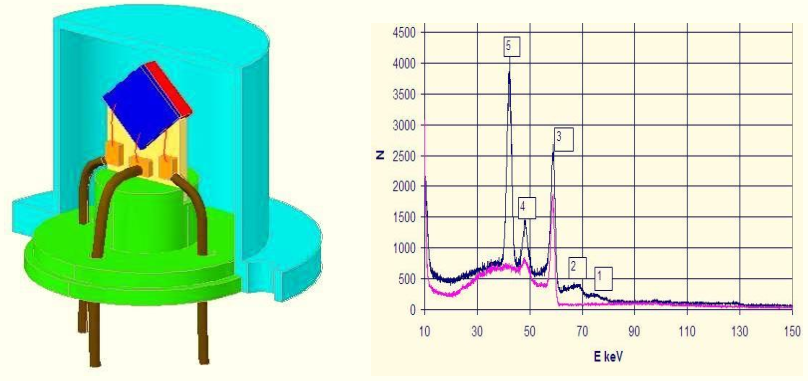
The technique of express-analysis of the concentration of medical radionuclides 99mTc, 67Cu using a detecting module based on the non-cooled planar silicon detector has been developed. The technique of express-analysis provides the measurement of the radiation spectra of medical radionuclides using the detecting module based of the non-cooled silicon planar detector and detecting module of a "scintillator silicon photosensor" type. A spectrometric device for express-analysis of radionuclide concentration was developed and its prototype, confirming the efficiency of the device, was made.
5 Development of an universal test platform for designing and testing silicon detectors in Kharkiv.
Within the STCU project № 9903 in close cooperation with the Kharkiv V. N. Karazin National University (KNU) on the territory of NSC KIPT a platform for research and development of single- and multi-cooled noncooled silicon planar detectors applied in the nuclear medicine is designed. It is planned to develop a complex of devices and techniques which allow studying and testing of all the detector characteristics before designing a detection module with read-out electronics. The test platform is designed and assembled in the following composition: an automated test station for studying and testing the electrophysical characteristics of silicon planar detectors (SPD); a test station with manual control for studying the SPD electrophysical characteristics; a single-channel spectrometer for studying the SPD spectrometric characteristics; a set of devices for fly-wire connection of SPD. Available equipment, tools and materials provide a full cycle of assembly operations when manufacturing single- and multi-channel detector devices based on SPD, including the fly-wire ultrasonic welding on crystals of detectors, plates and other components, bonding of all the device components as well as sealing of detector shell. This complex is designed not only for NSC KIPT works, but also for use in the process of teaching students of V. N. Karazin KNU and for research works in the field of SPD-based detecting devices in other universities and research institutions in Ukraine and foreign countries.
Selected publications in recent years
1. T.Horbatiuk, V.Kotlyar, M.Maslov, A.Safronov, Production of cc− and bb− Quark Pairs in pp Collisions at Energies of Experiments at the Large Hadron Collider, East European Journal of Physics, #1, 2019, p.40-45.
2. D.Burdeinyi, et al. The Coherent Bremsstrahlung Beam at MAX-lab Facility. Proceedings of the 51st Workshop of the INFN Eloisatron project "Charged and Neutral Particles Channeling Phenomena" Channeling 2008, Erice, Italy 25 October – 1 November 2008, p.49. World Scientific, The Science andCultureSeries – Physics.
3. V.B.Ganenko, D.D.Burdeinyi, V.I.Truten’, N.F.Shul’ga, K.Fissumd, J.Brudvik, K.Hansen, L.Isaksson, K.Livingston, M.Lundin, B.Nilsson, B.Schroder. Mechanisms of 200 MeV electron radiation in diamond crystal in the axial orientation. Nuclear Inst. and Methods in Physics Research B424 (2018) 17-25
4. V.K.Voloshin et al., "Multichannel spectrometric system based on the read-out chip with a self-starting VA2NA", Voprosy Atomnoj Nauki I Tekhniki. Seriya: “Yaderno-Fizicheskiye Issledovaniya”, 2013, № 6(88), p.165-169 (in Russian).
5. G.P.Vasilyev et al, Measurement of radiation energy by spectrometric systems based on the uncooled silicon detectors, Poverkhnost'. Rentgenovskie, synkhrotronnyye i nejtronnyye issledovaniya. - 2014, No 4, p. 94-100 (in Russian).
6. G.P. Vasiliev, et al, Measurement of Radiation Energy by Spectrometric Systems Based on the Uncooled Silicon Detectors, J. Surf. Investigation. X_ray, Synchrotr. and Neutron Techniques, 2014. v. 8, iss.2. p. 391-397.
7. G.P. Vasilyev, et al, Module for thermal neutrons registration based on uncooled silicon detectors and metal gadolinium converter, Problems of atomic science and technology. Series: Nuclear Physic Investigations, 2016, № 3, p. 99-104.
8. G.L.Bochek, et al, Registration of the thermal neutrons using uncooled Si planar detector, Problems of atomic science and technology. Series: Physics of radiation damages and effects in solids, 2016, №4(104), р. 107-112.
9. V.N.Dubina, , et al, Thermal neutrons detection module capable of electron and gamma-separation and background suppression, Problems of atomic science and technology. Series: Nuclear Physic Investigations, 2016, N5(105), p.88-93.
10. O.S. Deiev, et al, Method for express determination of medical radionuclides99mTc, 67Cu concentration using spectrometer based on Si planar detector, Problems of Atomic Science and Technology, 2017, № 6(112), Series: Nuclear Physic Investigations, p.117-121
11. O. S. Deiev, et al, Effective thickness of the planar detector in measurements of electrons energy loss, Problems of Atomic Science and Technology, 2017, N3(109), Series: Nuclear Physic Investigations (68), p.45-49
12. O.S. Deiev, , et al, Registration of thermal neutrons using two-detector module based on silicon detectors and metallic gadolinium, Sep. 24, 2018 - e-Print: arXiv:1809.08803 [physics.ins-det]
13. G.L. Bochek, , et al, Low-energy X-ray radiation after the biological shielding of electron accelerators, Problems of Atomic Science and Technology, 2018. №3(115) Series: Nuclear Physic Investigations p.172-177.
14. G.P. Vasilyev, et al, Technique of thermal neutrons registration by two-channel spectrometric system based on uncooled Si-detectors and gadolinium converter, Problems of Atomic Science and Technology, 2018, № 3(115), Series: Nuclear Physic Investigations, p. 111-117.
International Collaboration
1. "ALICE" CERN (Geneva).
2. Collaboration МАХ-TAG = MAX-lab of Lund (Sweden).
3. Institute of Physics of the Helsinki University (Finland).
4. Finnish Meteorological Institute in Helsinki (Finland).